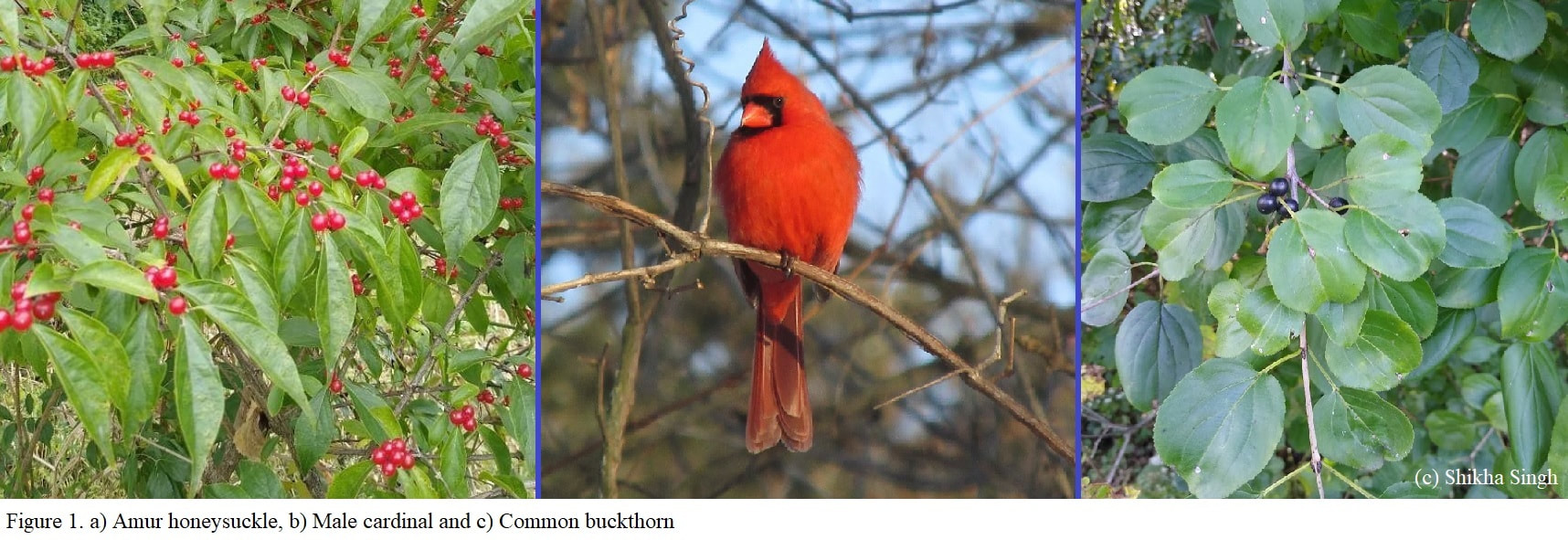Invasive species may be annoying to deal with throughout the year, but it is commonly thought to be a good food source in fall and winter, and a safe place for birds to nest. After all, we see birds eating and passing waste after eating the bright red berries of bush honeysuckle or the blackish-purple berries of buckthorn. However, research shows that may not be the case.
Throughout the year, many homeowners and land managers are dealing with invasive plant/shrub species. Despite our best efforts, these invasive plants and shrubs may go from a few individuals at a site to a full-fledged infestation within a year or two, partly because of its ability to adapt to the area, life history strategies, human activity, and wildlife, such as deer and birds. We know birds eat the berries of species such as amur honeysuckle (Lonicera maackii) and common buckthorn (Rhamnus cathartica), as we see their waste on our cars, bikes, sidewalks, and at times on people’s heads and clothing. Species such as multiflora rose (Rosa multiflora) do provide shelter for birds and were used for controlling soil erosion.
In order to look at just how much of a vector birds could be in the spread of invasive species, researchers looked at amur honeysuckle seed viability post bird gastrointestinal passage. Bartuszevige and Gorchov (2006) found that five out of the 17 bird species they looked at had viable seeds in their feces, and those five species are found within our region (American Robin, Cedar Waxwing, European Starling, Hermit Thrush, and Northern Mockingbird). Given that we have a lot of robins and starlings in the area, they have the potential to play an important role in dispersing seeds of various invasive species. The authors further suggested that “more viable seeds were deposited in edges, spurs, corridors and streams, and less in forest interior and fields, than expected” (Bartuszevige and Gorchov, 2006). These areas, especially edges and disturbed areas, are where invasive species tend to thrive. Disturbed areas are especially prone to invasive species invasions as they often contain open spaces, lack competition, contain high amounts of nutrients via runoff, and seeds can be deposited when people and equipment pass through.
Invasive species are problematic for a variety of reasons, one being that they out-compete native species and can create monocultures. This can reduce the amount of suitable habitat and food options for some bird species. Borgmann and Rodewald (2004) found Northern Cardinal nests to be almost 2.5 times higher in native shrub/tree species compared to invasive shrubs (honeysuckle and multiflora rose). In urban areas, daily mortality rates of the birds were higher in the invasive species compared to the native species (same trend was not found in rural areas). In addition to being an unsuitable nesting area, they are generally not the preferred food source for other bird species. Songbirds require food sources with high fat content in order to be able to complete their migratory journey, and it is critical that these resources are found along their migratory routes.
When native and invasive shrubs were present, songbirds consumed the fruits of the native shrubs at a faster rate than the invasive ones (Smith et. al., 2013). Invasive shrubs examined were multiflora rose, bush honeysuckle, and common buckthorn, all of which are established within the JLW CISMA region. Authors also performed a nutritional analysis on the berries of native and invasive shrubs during peak fall migration times. They found that native shrubs had significantly higher percentages of fat and energy density compared to invasive shrubs. Authors found that multiflora rose did have high amounts of flying insects, and that may benefit some species. However, another study found that caterpillar abundance was decreased in the hedgerows of invasive species compared to hedgerows of native species (Richards et. al., 2019). This may be problematic as birds such as robins, vireos, and Carolina Wrens eat caterpillars.
Based on these findings (this is only a short summary), one can see how complex the relationship between invasive plants and birds is. On the one hand, invasive species benefit from birds in the dispersal of their seeds. Birds may find plenty of food available, but it may not be the right type of food they should be eating before “running a marathon,” so to speak. On the other hand, berries do persist into the winter season, making it an emergency food source for birds that overwinter here. Before making any drastic changes to your backyard or parks, residents and land managers will need to assess what species they are trying to attract, research best management practices for their area, and be familiar with local, state, and federal laws. To avoid transporting and/or planting prohibited species. Once established, invasive species can be hard to contain and may make their way over to your neighbor’s yard (much to their annoyance). The good news is that there are many native plant species that can help attract the birds you want; one helpful resource is found on the Audubon website (click here)! If you have any questions, please feel free to contact JLW CISMA Invasive Species Coordinator Dr. Shikha Singh via email (shikha.singh@macd.org) or phone (517-395-2089).
~ by Dr. Shikha Singh, coordinator of JLW CISMA
This article was originally published on the JLW CISMA website on 10/10/2019 and has been reshared here with their permission.
For more information:
Michigan Audubon
Mi Bird-Friendly Communities: Bird-Friendly Plants
Michigan Native Plants for Bird-Friendly Landscapes booklet
Michigan Native Garden Design booklet
Audubon. 2019. Bring more birds to your yard with native plants. Date Accessed: October 11th, 2019
Website: https://www.audubon.org/native-plants
Bartuszevige, A.M. and D.L. Gorchov. 2006. Avian seed dispersal of an invasive shrub. Biological Invasions, 8: 1013-1022.
Borgmann, K.L. and A.D. Rodewald. 2004. Nest predation in an urbanizing landscape: the role of exotic shrubs. Ecological Applications. 14(6): 1757-1765
Richard, M., Tallamy, D.W. and A.B. Mitchell. 2019. Introduced plants reduce species interactions. Biological Invasions. 21(3): 983-992

